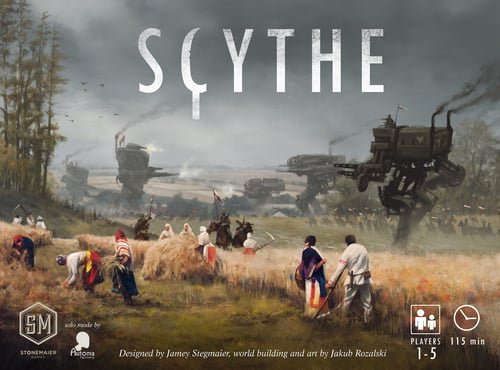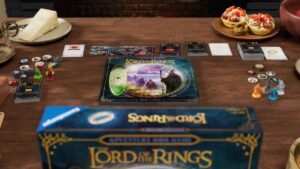Upon first opening Scythe, I felt sure I faced a gruelling multi-hour ordeal just setting it up and getting the hang of the rules. It might, I feared, even be the sort of game my friends and I tried playing only once, only to give up when midnight struck while we were still struggling through the first round. And who could blame me for the impression? The first thing I saw was a giant two-sided board on top of stacks of cards – event cards, factory cards, combat cards, objective cards. For each of the one-to-five players, a randomly assigned faction card, each with slightly different abilities. Then on top of that, a randomly assigned player mat, which was to be covered with wooden, Settlers-of-Catan-style pieces: cubes and cylinders and strange shapes of no obvious significance. Oh, and not one but two rule books.
Fortunately, first impressions can be misleading. Don’t get me wrong – it’ll take a while to set the game up the first time, but not as long as you’d think. And once you get started, play sails along at a good clip as you strive to establish the wealthiest empire in a steampunk version of a post-First World War land. You’ll soon be assigning workers to hexes to produce resources, which in turn can be used to build structures (sort of like Settlers of Catan) and deploying giant mechs to crush your enemies, scatter their workers, and steal their goods (sort of like the version of Settlers of Catan we’ve all been secretly yearning for. Or is that just me?). The end result is a fun, fast-paced game that looks fantastic and provides some real scope for strategy without drowning players in complexity.
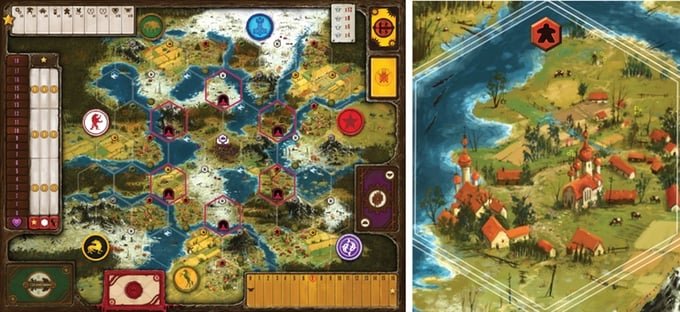
One thing about Scythe that does take a bit of getting used to, though, is tracking the status of the victory condition. You win by amassing the most money by the end of the game, but the coins in front of you are merely the liquid portion of your wealth. When a player ends the game by placing their sixth star (stars being obtained by achieving set goals), everyone gets a certain amount of coins – for each hex they control, for each unspent resource in their territories, for each star obtained. And the amount each is worth is modified by how much popularity a player has amassed. You can easily get a sense of how well each player is doing overall, but in close games it can be tricky to tell who is actually winning.
That minor grumble aside, Scythe‘s gameplay unfolds spectacularly smoothly and quickly. Your player mat is divided into four sections, and each section contains a top action and a bottom action. The top actions are centered on basic resource and unit generation and placement, while the bottom actions allow more advanced (and expensive) upgrades and permit the deployment of mechs. The key to the rapid pace of Scythe’s gameplay is that, at the beginning of your turn, you must choose one of the four sections of your player mat. As you can never choose the same section twice in a row, after your first turn, you only ever have three options to pick from. Then, if you have the necessary resources, you can do one, both, or neither of the listed actions in that section. That’s it. Mostly that boils down to trading basic stuff into the bank in exchange for good stuff, then trading that in for even better stuff. It takes very little time for even the most ponderously thoughtful player to make two simple trades, and many of the decisions can be made independently of what other players are doing. Indeed, a group of pacifist players could avoid any direct conflict with each other throughout the entire game.
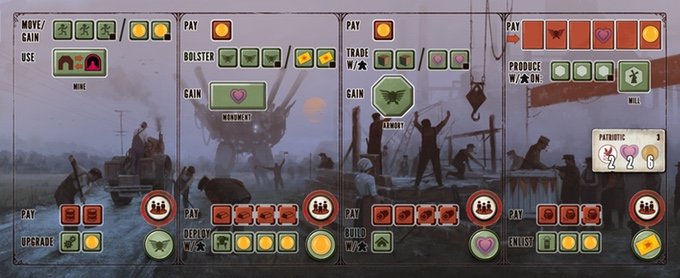
That said, a key part of the game consists of deploying mechs, represented on the board by lovingly designed steampunk figurines. And while even very aggressive players won’t want to fight often, what, really, is the point of having giant killer robots if you never pit them against other giant killer robots? The combat mechanics in Scythe are dead simple. To pick a fight, you just invade a hex containing an opponent’s mech(s) and/or leader with one or more of your own mechs and/or leader. Then, each player involved in the fray secretly chooses a certain amount of power to dedicate to the battle. You cannot bid more power than you have in reserve, but you also can’t bid more than seven power, no matter how much you’ve hoarded. Each player can also bolster their bid with combat cards (if they have some), up to one for each unit they have in the battle. The players then reveal their bids, and the highest bid wins, with ties going to the aggressor. Regardless of the outcome, both players must reduce their power level by the amount bid and discard any combat cards they used.
In theory, the system described above should make combat in Scythe an intricate game of bluff and counterbluff, an exemplary working of the complexities of game theory. After all, if both sides can bid the maximum allowed power (seven) and neither has any combat cards (or only the attacker does), the attacker can guarantee a win. And if the defender must lose, they might as well bid zero power, since doing anything else merely makes their loss worse. But knowing this, the attacker might as well bid only one power, since that will beat the zero bid and the attacker will then only have to lose one power instead of seven. But knowing that the attacker knows this, the defender will then bid two power, which will now be a winning bid. And so the attacker must bid three, and so on, until both are bidding seven again, which restarts the loop.
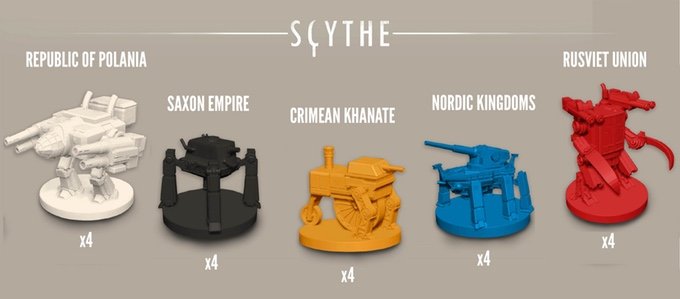

So, in theory, Scythe‘s combat presents a mighty logical puzzle. In practice, though, it tended to work the same way each time, at least in the games I played. The attackers bid what they needed to ensure they won, while the defenders bid nothing in order to limit their losses. This occurred because the stakes were almost always very much higher for the attacker than the defender. Someone attacking usually wanted to place a star for winning combat or to open a path to the centre tile. The person defending, on the other hand, generally faced nothing more than the loss of a hex and possibly one or two unspent resources, all of which could be easily recouped.
This isn’t necessarily a criticism of Scythe‘s combat. It doesn’t slow the game down, but still has enough underlying complexity that regular players can delve more deeply into strategic bidding over time. In that sense it is much like the game as a whole, which is composed of deceptively simple elements that allow new players to pick the basics up quickly while ensuring that more experienced players have plenty of opportunities for developing deeper strategies and tactics. It also feels a bit different from any other game I’ve played, generating a sense of each of us being a little disengaged from all of the other players even as we struggle to predict their movements and upset their plans. Oh, and that second rulebook I mentioned at the beginning: it turned out to be the rules for playing the game solo. I didn’t get a chance to try that variant, but given its genre, the fact that this game has been designed with a single player mode is inherently impressive. Overall, this is a solid, fun game that my friends and I will likely keep returning to.

